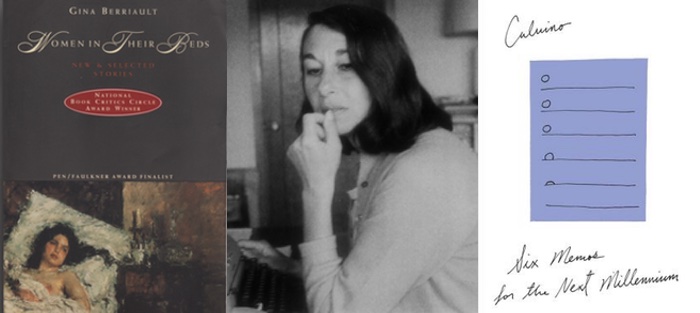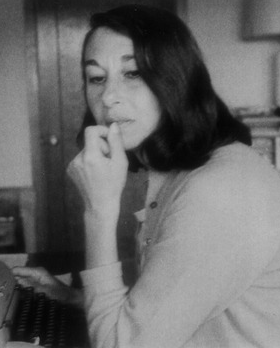Editor’s Note: For the first several months of 2022, we’ll be celebrating some of our favorite work from the last fourteen years in a series of “From the Archives” posts.
In today’s feature, part three of a three-part essay on defamiliarization, Christina Ward-Niven explores Gina Berriault’s “The Light at Birth.” This essay was originally published on December 7, 2016.
Language and Form in Berriault’s “The Light at Birth”
(and a few thoughts on lightness)
In the Chekhov and Welty stories, we see authors defy expectation—through surprising plot events, unusual point-of-view, atypical characterization—to tell stories of ordinary people who arrive at moments of significant insight. This is demonstrated in another way by a final story by another Chekhov fan, Gina Berriault. (She’s said to have displayed a framed photo of the Russian writer on her bookshelf.) “The Light at Birth” is similar in surface uneventfulness to the previous two stories covered here, and like the others, it achieves a remarkable balance of the familiar and the unfamiliar, setting up a culminating moment of illumination for both character and reader.
Berriault’s story is very short, focusing on a woman named Marie who is briefly staying on the upper floor of a California beach house owned by a 60-year-old German woman and her 96-year-old mother. Like Chekhov and Welty, Berriault gives us little backstory about the central character, or about any of the story’s three characters. We learn Marie is a teacher in San Francisco, and she is taking this break to rest and give her mind a “release from constrictions.” Her Jewish heritage is revealed later in the story, but only in minimal detail.
 Strictly limited backstory, common to all three of these stories, begins to seem characteristic of defamiliarization. Another way to think about this is in terms of the “lightness” of the characters, as defined by Italo Calvino. In his work Six Memos for the Next Millennium, a series of lectures published after his death in 1985, “lightness” in fiction means not weighed down—by heavy backstory, by extra description, by accurate-but-excessive details. Just a cleanly drawn, richly spare story. Calvino tells us that his writing career was defined by efforts to remove weight, “sometimes from people, sometimes from heavenly bodies, sometimes from cities; above all … from the structure of stories and from language.” This kind of lightness seems important in all of the stories I’ve discussed here, especially regarding character. Is it possible that for strangeness in a story to work best, it must be free of certain tethers that could prevent it from rising out of the recognizable ordinary and into another kind of recognition?
Strictly limited backstory, common to all three of these stories, begins to seem characteristic of defamiliarization. Another way to think about this is in terms of the “lightness” of the characters, as defined by Italo Calvino. In his work Six Memos for the Next Millennium, a series of lectures published after his death in 1985, “lightness” in fiction means not weighed down—by heavy backstory, by extra description, by accurate-but-excessive details. Just a cleanly drawn, richly spare story. Calvino tells us that his writing career was defined by efforts to remove weight, “sometimes from people, sometimes from heavenly bodies, sometimes from cities; above all … from the structure of stories and from language.” This kind of lightness seems important in all of the stories I’ve discussed here, especially regarding character. Is it possible that for strangeness in a story to work best, it must be free of certain tethers that could prevent it from rising out of the recognizable ordinary and into another kind of recognition?
The central characters in the Chekhov, Welty, and Berriault stories are ready to take flight in the moments of insight that lie at the heart of all three works. If we knew more about them as people, about their daily lives, problems, relationships, physicalities—“true” though those details might feel—would we be as able to accept their moments of surprising lift-off? Calvino called literature “the search for lightness as a reaction to the weight of living.” We simply don’t need the full heaviness of characters’ lives in these stories; we need to know just enough about them to understand that they, like all of us, carry with them the weight of living.
Beyond limited character background, Berriault’s “The Light at Birth” jostles us with the writing itself. From the beginning, the prose is imbued with a strangeness—of tone, of mood—that is a direct result of Berriault’s stylistic choices. Her language, her sentences, her transitions between paragraphs—all play a role in achieving beauty and unexpected truth in what might seem at first like a very simple narrative.
The story’s first sentence is striking and unmoors us already: “The immensity of light—the glare from the winter sky and the reflected glare from the ocean—shocked her asleep at noon, at two o’clock, at any hour of the day.” What exactly does that mean, we wonder: how does light shock someone into sleep? When something shocks, we imagine jolting: alert, awake. And for most of us it is darkness that induces slumber.
The sentence doesn’t make complete sense on first read, and that’s one reason I love it as an opening sentence. It speaks to the value, at times, of letting go of clarity—or perhaps to the idea that clarity can be reached via winding paths, and the reading experience may be all the richer for the wandering. We continue through the opening paragraph and begin to intuitively understand: “She had always resisted sleep in the day except when she was sick and when, after loving, she had fallen asleep with a lover; but this sleep was an edict as from a healer more powerful than her own self, the self that had lost for a time the sense of how to heal itself in its own way.” Berriault is laying groundwork for her character, whom we now realize is in need of some kind of healing, and thus needs to rest—to recover—even in the day. So her sun-induced sleep is not so bizarre, after all. By reframing a familiar idea (a person in need of extra rest) through surprising, unlikely language, the author allows us to see something in a new way, to pay attention in a new way. This is exactly what Shklovsky discusses in “Art as Device”: the idea of making something visible by foregoing conventional labels for less expected language—sometimes even describing something as if it were being perceived for the first time.
More explanation for Marie’s actions comes two paragraphs later. But as is Berriault’s way, even the “explanation” keeps a stylistic inventiveness in play:
The ocean had been her first sight of the vastness of the earth when she was a child in a beach town down near the border, and she had come to the ocean again, to this town north of San Francisco, to find again that vastness, now when she was in dire need of release from constrictions on the mind, which was such easy prey to all things that kept it small and afraid. The sleep was like basking in light, and after three days of it she came awake.
The phrasing here is more opaque than clear; it is familiar, yet not. We understand her nostalgia for the endless ocean of her childhood (“to find again that vastness”), which seems also like nostalgia for the open-endedness of youth. But we have to slow down to absorb the meaning of “dire need of release from constrictions on the mind, which was such easy prey to all things that kept it small and afraid.” What are these things that keep her mind small and afraid? We don’t know. But we don’t need to—we understand enough for this early point in the story: this character needs a mental break from her daily life.
“The Light at Birth” offers many sentences like that one, which defy understanding just enough to encourage the reader to pause and pay closer attention (just as Marie herself is pausing in her own life, to pay closer attention). Marie stands on her porch and throws bread to seagulls: “Close, hovering, their spread wings and tails pure white and translucent in the light, they were unfamiliar, nameless creatures. When there was no more bread and they returned to the sand, they became again familiar.” Marie knows they are seagulls; the birds aren’t actually “unfamiliar” and “nameless.” But some things, some people, some ideas are easier to grasp from a distance than when they are within reach, perhaps because we rarely encounter them at close range. Berriault’s language in this passage draws attention to itself, so that we remember these lines a few paragraphs later, when Marie grows uncomfortable sitting with the German women in the house. She recalls traveling to Germany the year before, feeling “past terrors lurking, as if what had happened in that country was happening still or was about to happen always.” Up close, Germans are troubling to her, they “cause confusion in her heart”—even if at a distance she recognizes them for who they are: not the enemy anymore. This unfolds further when we learn, later in the story, that Marie’s parents were Jewish refugees who fled Germany.
The story challenges us, again, when Marie thinks about her job in San Francisco:
…was any student wondering what had become of her, the lost professor? So many gentle sermons she had delivered on the necessity to clear one’s mind of its landmines, of its traps for strangers who come near, those deathtraps that destroy the self as well as the stranger. Let in some light, she had told them. Let in some light, she pleaded with herself, alone.
Marie wants to take her own advice, the advice she gives her students, but the meaning of the advice itself—“let in some light”—is not immediately clear. We have to stop and think through the language, to try to understand the intended meaning. (Shklovsky’s laborious perception again at work.) If Marie wants to “let in some light,” she is trying to brighten some kind of darkness—a darkness in her mind, perhaps an ingrained bias that makes her unable to connect with “strangers who come near.” If so, it is an openness she is seeking, as one would open curtains to let in the sun—an open mind and a willingness to face the unknown without fear. But the words are surprisingly strong; Marie wants to be rid of “landmines” and “deathtraps” that “destroy” her as well as the stranger. This goes beyond mere openness for the sake of kindness; it is a life-or-death idea for her. “Let in some light” begins to sound more like “let in some life.”
The word “light” is repeated many times throughout this brief story—from the title to the final paragraph. Other words are notably repeated, as well—“dark,” “storm,” “strangers.” Berriault’s use of repetition gives the story a musical quality. And the recurring words feel like an offering from the author: I will not spell out my meaning, but I will offer clues.
 Berriault’s transitions between paragraphs can be jarring. She frequently jumps from scene to scene, abruptly, without any bridging language; again, we have to pay close attention to keep up. This kind of transitioning (or lack thereof) also automatically links the ideas in two separate scenes, simply via proximity on the page. The paragraph in which Marie feeds the seagulls on the porch and notes their close-range foreignness is directly followed by: “The old mother, wrapped in a large, richly blue woolen shawl, sat on a sofa in the front room, and her blue, long-lidded eyes appeared unseeing. A storm, rising up over the horizon at noon, was sweeping tatters of fog before it, and the room was dark one moment and bright again the next.” We link the strange seagulls with both the old woman (who is as unfamiliar to Marie as the birds are) and the storm, which becomes a central metaphor, representing Marie’s ongoing internal struggle, as well as her family’s trauma during World War II.
Berriault’s transitions between paragraphs can be jarring. She frequently jumps from scene to scene, abruptly, without any bridging language; again, we have to pay close attention to keep up. This kind of transitioning (or lack thereof) also automatically links the ideas in two separate scenes, simply via proximity on the page. The paragraph in which Marie feeds the seagulls on the porch and notes their close-range foreignness is directly followed by: “The old mother, wrapped in a large, richly blue woolen shawl, sat on a sofa in the front room, and her blue, long-lidded eyes appeared unseeing. A storm, rising up over the horizon at noon, was sweeping tatters of fog before it, and the room was dark one moment and bright again the next.” We link the strange seagulls with both the old woman (who is as unfamiliar to Marie as the birds are) and the storm, which becomes a central metaphor, representing Marie’s ongoing internal struggle, as well as her family’s trauma during World War II.
A paragraph of dialogue by Leni, the German daughter, about the blooming trees near her childhood home in Heidelberg, is followed not by a response from Marie, but instead by a description of the thrashing storm: “The storm was on them, the house went dark in the heavy rain. She ran back up the stairs and into her rooms and watched the waves flinging ashore timbers and branches that had been rushed down the rivers weeks ago…” This abrupt transition makes us feel that Marie’s response to Leni is the dark storm, her own mind flung ashore in reaction to Leni’s fond memories of Germany.
Another unusual transition occurs about two pages later. It is the next day, the storm is over, and Marie is again conversing with Leni. Voice trembling, Marie reveals her Jewish background to the other woman, and Leni responds with another story of her own childhood—this time detailing the trip immigrating with her mother from Germany to the United States. Leni implies that her mother was treated badly in Germany, that her mother’s German identity was questioned. We are again given only the barest of details—did the Germans suspect her mother of being a Jew? we aren’t sure—and Marie does not ask a single question during Leni’s story, nor does she utter a single word, in fact. (Is this the way people usually converse in “real life”? No. But something would be lost, I think—momentum, tension—if it was written as a back-and-forth conversation. The unbroken flow of Leni’s speech gives the scene its power.) Her monologue closes with: “An English minister who was a passenger gave sermons, and I went to hear every one. He felt sorrow for the world. We all felt sorrow for the world on that empty big ship.” There is no response from Marie, just an immediate jump to a new scene:
She went along over the wide strip of wet sand and broken shells as far as the lagoon, a long way. Higher up on the sand lay a number of shore birds, dead from the storm. The sea was dazzling, and the air so clear the little islands, miles away, were visible. She came back while the sun was forming into an oblong blazing jewel at the horizon.
It’s an odd jump: no transitional language, and the use of the pronoun “she,” just after Leni’s spoken words. The “she” here should logically refer to the character who just finished speaking—Leni. On first read, we might pause for a second to wonder who, exactly, is walking on the beach. We quickly realize “she” is Marie, but I see this momentary confusion as intentional by Berriault. She could have easily begun the paragraph with Marie’s name. As it stands, we stop, we think about who “she” is—and that brief instant of confusing Leni and Marie may have symbolic purpose. The two women have grown closer. The divide between them, the divide that is an ongoing source of turmoil for Marie, is a bit narrower now.
The image of birds here on the beach—echoing the birds earlier on the porch, and directly following Leni’s words about traveling during World War II—is significant, because now the birds are dead. Yet: the sea is “dazzling,” the air is “clear,” the sun is a “jewel,” and Leni, now aware that Marie is Jewish, has expressed a “sorrow for the world.” In this paragraph Marie acknowledges the vastness of the sea that she sought when she arrived, and perhaps she is beginning to allow in the empathy and light of a German stranger—even if she isn’t free of the storm and death that is an inescapable part of her history.
Berriault’s stylistic choices accumulate to set us up for the final scenes and for the central character’s key moment of revelation—a moment that is strange, not fully comprehendible, and yet also recognizable. (Defamiliarization at its best, I think.) After Marie struggles to overcome her resistance to the German strangers in the house, and to overcome whatever darkness it was that sent her out of the city, she is invited by Leni to step into the elderly mother’s bedroom. The old woman lies curled up in bed, near death. Leni says that her mother dreams of garden parties, beautiful light, and strangers. The sight of the woman in the bed reminds Marie of her own mother’s death, and she has to “back away from the sight, step back and cover her face to hide her grimace of sorrow over the old mother, over the memory of her own mother, dying.” This moment of connection—Marie is open enough to feel sorrow for both the dying German woman and the loss of her own mother—takes us into the final beautiful, moving paragraph:
She was wakened in the night by the strangers at the old mother’s garden party. Visions of light and of luminous strangers in that light, that was what the dying saw. She knew who they were, those strangers. They were the first of all the many strangers in your life, the ones there when you come out of the dark womb into the amazing light of earth, and never to be seen again in just that way until your last hours. She got up and walked about, barefoot, careful to make no sound that would intrude on that gathering of strangers in the little room, below.
These closing lines contain the most intriguing language of the story, as well as the most unusual imagery. The first sentence of the paragraph gets its power from the words Berriault has chosen to leave out, much as the story up to now has been strengthened by backstory left out, by explanatory transitions left out. (Calvino’s ideas of “lightness” apply again, which is all the more interesting given the thematic emphasis on “light” in this particular story. Berriault is referring to a different kind of light, of course, but her character seems as though she’d be as interested in Calvino’s idea of “non-heavy” lightness as she is in her own idea of “non-dark” lightness.) The strangers at the garden party exist only in the dying woman’s mind. Yet the language is specific here: Marie is wakened not by dreams or thoughts. She is wakened by the strangers themselves. And she walks carefully around her room so as not to disturb the “gathering of strangers” below.
How are we meant to take these literal references to the old mother’s imagined strangers? At the core of this paragraph is something about the surprise and mystery of human connection, and the wonder of being alive. Marie, by the end of the story, feels that she understands the old woman in some way; she even has a sense of recognition as to what the woman is going through, as she lays dying. Berriault uses language that tells us Marie actually sees the woman’s visions—something clearly impossible, but also something that conveys the profound empathy in action here. This is a dramatic change from earlier in this story, when Marie could not help but view the old woman as a physical representation of Nazi Germany.
Is this a full, unexpected reversal, then, as we saw in “The Student”? I don’t think so. Marie, from the start, seeks to “let in some light” and be open to strangers like Leni and her mother. She’s aware that in the past she “mistook strangers for the enemy.” So the strangeness here isn’t Marie’s change of heart; in a way, the change of heart is exactly what we expect. In fact, the story’s outcome is actually predictable, on a basic plot level. But the prose is thoroughly unpredictable—the surprise lies in the way Marie’s change is described. This, to me, is the magic of defamiliarization: Berriault could have written the closing in a more straightforward way—describing a moment of connection between women—but her decision instead to use unusual, not-easily-understandable language and syntax may, paradoxically, allow the reader to understand more: more deeply, beyond the surface message of the story (the beauty of empathy between strangers). We have to pause and think about these luminous strangers at birth and death, figure out our own interpretation, and absorb the meaning. There is something in that process—in the pausing, thinking, interpreting, absorbing—that allows us to connect with the ideas on a deeper emotional level. I finish “The Light at Birth” with a sense of recognition that is hard to fully explain: I understand Marie’s internal journey through this stormy beach weekend, and I agree with her about beauty of strangers and light in this life—a beauty that is at its purest at birth, before life has a chance to inflict and affect—and I feel both moved and saddened by the fact that we may, indeed, appreciate that beauty most when life is near its end.
I’ve looked here at the role of strangeness in three stories—its power to unsettle and lead the reader to moments of unexpected recognition. But there’s something else interesting going on in these works thematically, something to do with strangers and connection. All three stories feature central characters who interact with unknown people (in the case of “The Student,” nearly unknown) and these interactions lead to profound moments for the protagonists. Ivan, the student, stops to speak with two widows on his walk home, and he is transformed by their displays of emotion for an ancient biblical figure. The unnamed American girl travels with strangers to Cork, and in the end finds comfort and hope in a “lovely room full of strangers.” Marie interacts with two strangers in a beach house and, in doing so, comes to show empathy for people she previously could not help but consider the enemy.
For these characters, a conscious decision to divert from their regular routine and interact with unfamiliar people leads to moments of heightened understanding about themselves and others. In other words, contact with the strange (“strange” in the sense of an out-of-the-ordinary person) illuminates; strangers are the defamiliarizing forces for these characters. Could this be helpful to us in our own fiction? We introduce strangeness to benefit our story and the reader; we introduce strangers to benefit our characters? It’s a worthwhile experiment: have your character turn away from the familiar and interact with someone unknown. Consider how that kind of unpredictable interaction—for us, for our characters—can sometimes have emotional resonance.
This idea of “using” defamiliarization, however, brings up the complicated topic of intentionality. I began this essay suggesting that writers can intentionally defamiliarize—purposely inject the unfamiliar into their work. I believe that’s true, that this is a technique we employ to make the ordinary come to life. And yet authorial intention is up for debate in these stories. Did Chekhov, Welty, and Berriault aim for strangeness? Or did they think of their narrative choices in completely different ways? My daughter created one of my favorite paintings through accidental defamiliarization; she focused so intently on making one image match her vision, she ended up with something more affecting and interesting (at least to one biased viewer). Something for us to remember as writers: rather than aiming for strange, we might at times simply loosen our ties to the so-called “realistic,” and see what evolves. The result may be something different, but more powerful, than our original idea. Staying open to the unusual, then, and paying attention, may be even more valuable than trying for strangeness.
In the end, it seems, the power of strangeness has much to do with paying attention. The characters in “The Student,” “The Bride of the Innisfallen,” and “The Light at Birth” pay attention to unfamiliar people. As readers, the unfamiliar in a text leads us to look more closely, consider more deeply, and possibly find something even more recognizable. (In our everyday “real lives,” surprises amid the mundane may be all around us. If we take the time to notice them—if we look up from our phones—they may have something to tell us.)
For writers, the route to illumination through strangeness may be both a matter of intention as well as something less strategic—something more mysterious and, potentially, more exciting for us during the creation process. Let us stay open to the misfit detail, the unusual way of perceiving, the unexpected narrative event. As we navigate the ordinary of our fictional worlds—evening walks home in the cold, crowded train rides, stormy weekends in beach houses, or even just quiet moments on moonlit hills—we’d be wise to invite amorphous creatures to join us on the page. And, wiser still, to pay attention to creatures who arrive uninvited.







